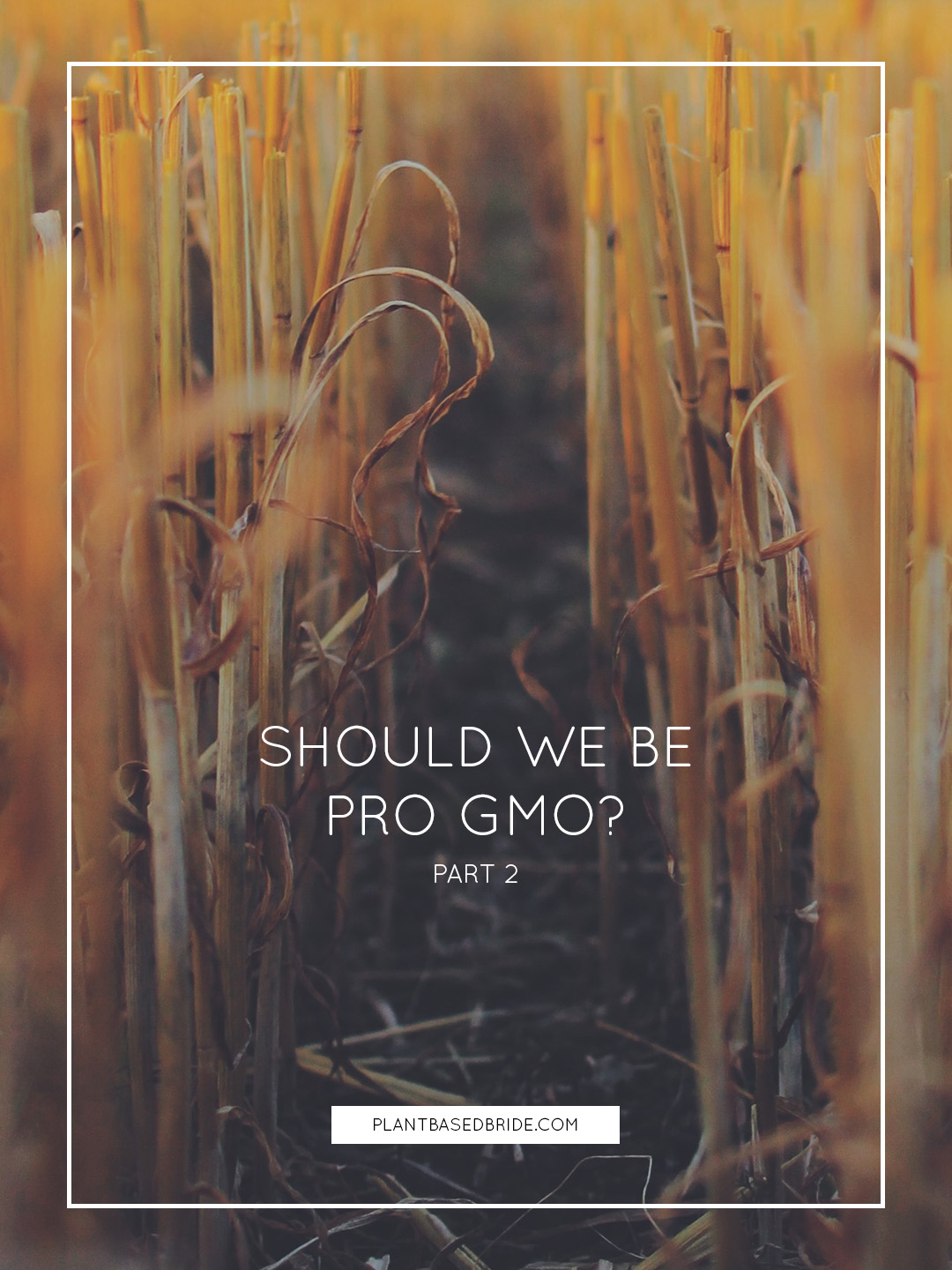Should We Be Pro GMO? (Part 2)
Welcome back to the second part of my 2-part series on GMOs! Last week we talked about the health impacts of GMOs and their effect on animals. (Go read that article here, if you haven't already!) This week we'll chat GMOs and the environment, and briefly touch on the "big bad monster" of the industry - Monsanto.
So, what are the impacts of GMOs on the environment?
Water use
One side claims that additional traits engineered into GMO crops cause them to require more irrigation, while the other states that organic farming is the one that requires more water. So which is it?
Kristine Nichols, the chief scientist for the Rodale Institute, put it this way:
"I like to say that microorganisms are like little engineers. They build out these systems and engineer the environment to be beneficial for the plants so that the plants will feed them in turn."
She's referring to the ability of these microorganisms to build up in organically farmed soil, forming mutually dependent relationships with the plants. Fungi, for example, create microscopic channels that carry nutrients and water through the soil.
This results in the soil in organic fields absorbing more water, storing that water better, and needing less water overall. Organic soil also did better at replenishing groundwater supplies in this study. This ability of the soil allows for organic crops to draw on plentiful water during drought. Conventional and GM crops do not have this ability due to the soil's reduced ability to store water.
However, some farmers, like Joel Nelson (the President of the California Citrus Mutual growers association), are skeptical about differences in water use. He said:
"Organic HAS NOTHING to do with water usage. Our organic producers achieve a yield, generally 40 percent less than conventional producers, but all of them require the same amount of water."
As there are so many other factors involved in water requirements for crops, it's difficult to say who's right.
Land use and destruction of natural habitats
While GMOs don't necessarily produce higher yields than non-GMOs (as seen in GM cotton in India, which we will discuss later), organic crops have been shown to produce only around 80% of the yield potential from a conventional crop per unit of land. For this reason, organic farming actually requires more land to feed the same number of people as conventional agriculture.
Many of you are likely already aware of the 850 million hungry people in the world, and the rainforest destruction of approximately an acre per second, mostly for agricultural purposes. Using MORE land to produce the same amount of food is in no way environmentally friendly.
However, you may also already be aware that it takes ten times more crops to feed people when we first filter the crops through animals, rather than feeding the plants to humans directly. In other words, animal products produce only 10% of the yields of plants, however they're grown. For every 10 lbs of grain fed to a cow, only 1 lb of beef will be produced.
If we really want to feed the hungry without using more land, we should be reducing our meat and other animal product consumption. For this reason, I find the 'land use' argument for GMOs less than compelling.
Pollution by synthetic fertilizers and pesticides
Firstly, I want to make it clear that organic farms still use pesticides. It is a commonly held belief that organic farms use little to no pesticides, but that is simply a misconception. In reality, organic farms can use as many if not more pesticides on their crops due to lowered effectiveness. Sadly, large farms (organic or not) are more concerned with yield and profit than the health of the soil, the environment, and consumers. They often use pesticides liberally to reduce competition from other plants. The difference is that organic farms use organic pesticides, rather than synthetic ones.
So what's worse: organic or synthetic pesticides?
Organic pesticides come from natural sources and are un- or lightly-processed before use, rather than being developed synthetically. It has long been thought that organic compounds are safer for us and the environment, but many natural pesticides have been found to have serious health risks.
An example is Rotenone, a highly dangerous natural pesticide which has been shown to produce Parkinson's Disease-like symptoms in rats. It is potentially deadly to various species, including humans. Just because something is natural, doesn't mean it can't kill you.
More and more testing is showing that many organic pesticides, believed to be safe, are not.
But are synthetic pesticides any better?
A Canadian study found that organic pesticides meant to control soybean aphids were actually more ecologically damaging than the synthetic pesticides, as well as less effective.
Unfortunately, one blanket statement can't be made. It depends so greatly on the specific farm and its specific practices. Some organic farms use no pesticides, as do some conventional farms. Some conventional farms spray pesticides twice a month, and some organic farms spray just as frequently.
The only way to know is to buy local produce and actually talk to the farmer about their practices.
One thing we can say for certain is that overuse of pesticides and herbicides is a problem. Hundreds of millions of pounds of herbicides and pesticides are applied to farmlands. As a result, weeds and pests are becoming resistant to compounds such as glyphosate - leading to the use of stronger herbicides, such as with the case of Pig Weed's resistance to Roundup after a couple of decades of use.
The increased use of herbicides and pesticides in conjunction with both organic and GMO crops leads to pollution of water, soil, and air.
This is a problem that cannot simply be ignored.
Conservation of soils and biodiversity of crops and wildlife
We spoke of how organic farming often leads to healthier soil, full of microorganisms and fungi. In contrast, GM crops' roots can release toxins into the soil leading to fewer soil bacteria - integral to healthy, nutritious soil, needed for proper growth without chemical fertilizers. In addition to the impact on the soil, irrigation of these GM crops carries these toxins into our water and air - exposing various plant and animal species to the negative effects.
It is also true that organic farms tend to favour crop rotation rather than monoculture. The rotation of crops helps substantially in preventing soil degradation. GM crops are far more likely to be grown as monocultures, depleting the soil of important nutrients and reducing diversity. In a monoculture style of farming, nutrients are not returned to the soil - allowing it to become dry and void of nutrients.
The "strong" genes of GM species may lead to a large-scale whipping out of other varieties of plants, reducing the diversity of life on Earth in an irreversible fashion. Once GM DNA has been introduced to the environment, it cannot be extracted.
Gene flow, invasiveness and super weeds
Gene flow, the movement of genes from one population of plants to another by way of pollen and seeds, is cited as a reason for caution in using GMO crops. As GM seeds spread, as does their altered DNA - small genetic alterations in plants may cause much larger ecological shifts. These GMOs have the potential to overtake other, "weaker", plants in both agricultural and natural conditions. GMO plants have the ability to become invasive species in our already fragile natural ecosystems, as occurred in North Dakota in 2010 with GM canola. It is impossible to know the reprocussions of this kind of spreading of GM plants. Once a plant has been introduced, it will inevitably become part of a larger ecosystem.
There is also the problem of 'super weeds' - non-target plants that become resistant to pesticides and herbicides and have the potential to take over agricultural and natural habitats in much the same way as genetically engineered crops.
Fuel use
As of now, there seems to be no substantial difference in the fuel use by organic and GM farms. There is, however, the potential to engineer crops able to fix their own nitrogen - a trait that could drastically reduce energy consumption on farms by eliminating the natural gas currently used in synthesizing ammonium nitrate and the fuel used in trucks that transport fertilizers to farms.
What about Monsanto?
Monsanto has become synonymous with the 'evil corporation'. There are horror stories of lies, mistreatment of farmers, and lawsuits. Some of these stories are true, and some aren't, but that's not really the point. A vast majority of large-scale corporations have questionable ethics in the face of potential profit, and Monsanto is no different. These include less-than-ethical business practices, extreme opposition to transparent labelling, and the revolving door of employees between Monsanto, the USDA, the FDA, and the US government.
The problem with patenting seeds
Monsanto is at the centre of the seed patenting debate because they are the largest seed company in the world. They have taken over the majority of seed companies and control 95% of the cotton in India and 90% of the soy in the US, not to mention large amounts of other crops.
Everything begins with a seed - seeds are the source of life, and renewal of life. Monsanto is trying to privatize it. The patenting of a seed is problematic is so many ways. Private companies shouldn't control the first step in the food chain any more than governments should. We need seeds to survive, and we as individuals should have the right to grow food.
Dr. Vandana Shiva has pointed out that the only way to claim a patent on a seed is to alter it, to genetically engineer it. Once this has been done, the seed can be claimed as an invention, as intellectual property. This allows a private company to exclude others from having or using these seeds. This is a slippery slope, and dangerous for our already flawed food system. There is no benefit for the larger population in the patenting of seeds. This is simple corporate greed.
The patenting also causes another issue - it allows Monsanto to restrict independent scientific research on their seeds, making it almost entirely impossible for independent entities to verify their claims. Monsanto says that GM crops are superior to non-GM crops, but they don't allow scientists without ties to the corporation the freedom to study them.
Many point to cross-pollination of GM and non-GM crops as one of the biggest problems with GMOs. They talk of Monsanto's criminal suits against farmers whose crops were contaminated by patented seeds. Further research seems to indicate that this is less of a problem than we have been made to think.
However, there is still a real impact on farmers.
Impact on farm workers
The severe impact of Monsanto's business practices on small farmers is never clearer than in India.
Since the introduction of Monsanto's Bt cotton to India in 1998, the price of cotton seeds has increased by almost 80,000%. (Yes, 80,000%, that's not a typo.) This exorbitant price increase combined with the fact that new seeds must be purchased every year have lead to economic hardship among small farmers in India. In addition to these problems, far lower yields than promised (the claim from Monsanto was 1,500 kg of cotton per acre, while the average actual yield was only 400 kg of cotton per acre) leaves farmers without future prospects. As a result, approximately 300,000 Indian farmers have committed suicide after being trapped in cycles of debt and crop failure. 84% of these deaths have been directly associated with Monsanto's Bt cotton.
There is also an impact on the farmers in their physical health due to close proximity to toxic chemicals such as those found in Roundup. Entire communities have been impacted in places like South America, where thousands of families who have been farming the land for generations have been displaced to poor urban areas due to their inability to compete with agribusiness conglomerates growing GM crops. There have even been reports of killings of farmers who have protested the loss of their livelihoods.
You may have noticed that the question of the safety and validity of GMOs is not cut and dry, not black and white. Can GMO crops be good for people? Yes, they can. Can they be good for the environment, with proper development? I think so. There are so many pieces to this puzzle; so many variables.
GMOs aren't inherently bad, but they also aren't inherently good.
Right now, today, they bring bad things along with them. Monsanto and the patenting of life. Pesticides and herbicides and their severe impact on our health, the animals, and the environment. Monoculture and soil depletion.
The problem? Organic farms aren't all that much better. Our food system is broken, and none of our current options can fix it.
A truly sustainable future would utilize more natural processes, such as many of those used in organic farming, in combination with technological advancement to create nutritious crops that can be grown responsibly with net positive outcomes for the soil and environment.
A sustainable future would see advancement for the good of humanity, the animals, and our planet without privatization and monopolies controlled by big corporations.
We need to encourage boh sides to work together to find our best bet for a sustainable future. As allies, the GM and organic industries could revolutionize our food system for the better.
I hope you enjoyed this two-part series on GMOs and would love to hear your thoughts in the comments.
Until next time,
Sources:
https://www.youtube.com/watch?v=9_izCPy7yvs
http://www.mdpi.com/1099-4300/15/4/1416
http://www.mdpi.com/1099-4300/15/4/1416/htm
https://www.youtube.com/watch?v=aA4I-WRu_s0
http://www.onegreenplanet.org/animalsandnature/the-environmental-impact-of-gmos/
https://www.researchgate.net/profile/Jacek_Strojny2/publication/293647479_IS_GMO_SUSTAINABLE_A_REVIEW_OF_THE_ENVIRONMENTAL_RISKS_OF_GM_PLANTS_IN_COMPARISON_WITH_CONVENTIONAL_AND_ORGANIC_CROPS/links/56e1cad508aebc9edb19c87f.pdf
http://www.cnbc.com/2014/12/09/rought-resistant-report.html
https://blogs.scientificamerican.com/science-sushi/httpblogsscientificamericancomscience-sushi20110718mythbusting-101-organic-farming-conventional-agriculture/
https://www.geneticliteracyproject.org/2013/10/15/organics-versus-gmo-why-the-debate/
https://vimeo.com/45691238/description
http://www.foodispower.org/gmosnanofoods/
http://environment.nationalgeographic.com/environment/global-warming/food-how-altered/
http://www.fao.org/docrep/003/X9602E/x9602e07.htm
http://earthjustice.org/features/engineering-an-environmental-disaster-2#
http://www.ewg.org/agmag/2016/03/are-gmos-bad-environment
http://centaur.reading.ac.uk/39676/
http://www.nature.com/nbt/journal/v20/n6/abs/nbt0602-567.html
http://www.lcafood2014.org/papers/137.pdf
http://gmo.geneticliteracyproject.org/FAQ/organic-non-gmo-farming-sustainable-farming-using-gmos/
http://www.navdanya.org/news/573-monsanto-vs-indian-farmers























